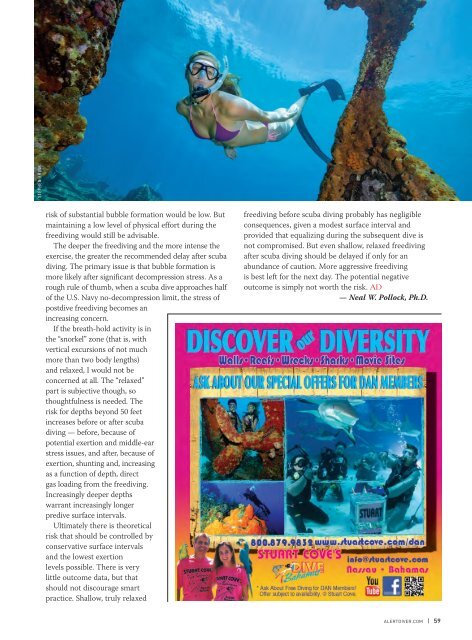AD 2016 Q3
Alert Diver is the dive industry’s leading publication. Featuring DAN’s core content of dive safety, research, education and medical information, each issue is a must-read reference, archived and shared by passionate scuba enthusiasts. In addition, Alert Diver showcases fascinating dive destinations and marine environmental topics through images from the world’s greatest underwater photographers and stories from the most experienced and eloquent dive journalists in the business.
Alert Diver is the dive industry’s leading publication. Featuring DAN’s core content of dive safety, research, education and medical information, each issue is a must-read reference, archived and shared by passionate scuba enthusiasts. In addition, Alert Diver showcases fascinating dive destinations and marine environmental topics through images from the world’s greatest underwater photographers and stories from the most experienced and eloquent dive journalists in the business.
You also want an ePaper? Increase the reach of your titles
YUMPU automatically turns print PDFs into web optimized ePapers that Google loves.
STEPHEN FRINK<br />
risk of substantial bubble formation would be low. But<br />
maintaining a low level of physical effort during the<br />
freediving would still be advisable.<br />
The deeper the freediving and the more intense the<br />
exercise, the greater the recommended delay after scuba<br />
diving. The primary issue is that bubble formation is<br />
more likely after significant decompression stress. As a<br />
rough rule of thumb, when a scuba dive approaches half<br />
of the U.S. Navy no-decompression limit, the stress of<br />
postdive freediving becomes an<br />
increasing concern.<br />
If the breath-hold activity is in<br />
the “snorkel” zone (that is, with<br />
vertical excursions of not much<br />
more than two body lengths)<br />
and relaxed, I would not be<br />
concerned at all. The “relaxed”<br />
part is subjective though, so<br />
thoughtfulness is needed. The<br />
risk for depths beyond 50 feet<br />
increases before or after scuba<br />
diving — before, because of<br />
potential exertion and middle-ear<br />
stress issues, and after, because of<br />
exertion, shunting and, increasing<br />
as a function of depth, direct<br />
gas loading from the freediving.<br />
Increasingly deeper depths<br />
warrant increasingly longer<br />
predive surface intervals.<br />
Ultimately there is theoretical<br />
risk that should be controlled by<br />
conservative surface intervals<br />
and the lowest exertion<br />
levels possible. There is very<br />
little outcome data, but that<br />
should not discourage smart<br />
practice. Shallow, truly relaxed<br />
freediving before scuba diving probably has negligible<br />
consequences, given a modest surface interval and<br />
provided that equalizing during the subsequent dive is<br />
not compromised. But even shallow, relaxed freediving<br />
after scuba diving should be delayed if only for an<br />
abundance of caution. More aggressive freediving<br />
is best left for the next day. The potential negative<br />
outcome is simply not worth the risk. <strong>AD</strong><br />
— Neal W. Pollock, Ph.D.<br />
ALERTDIVER.COM | 59









